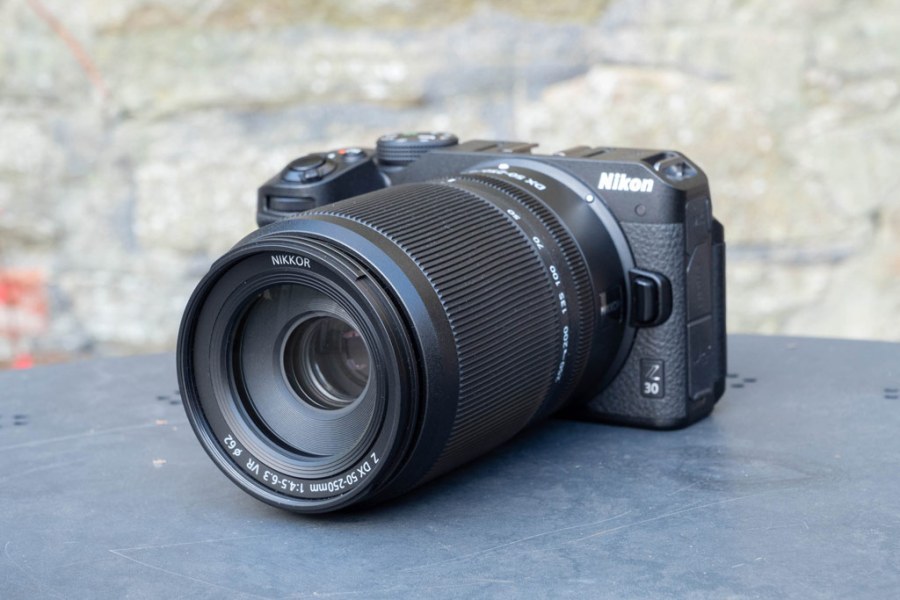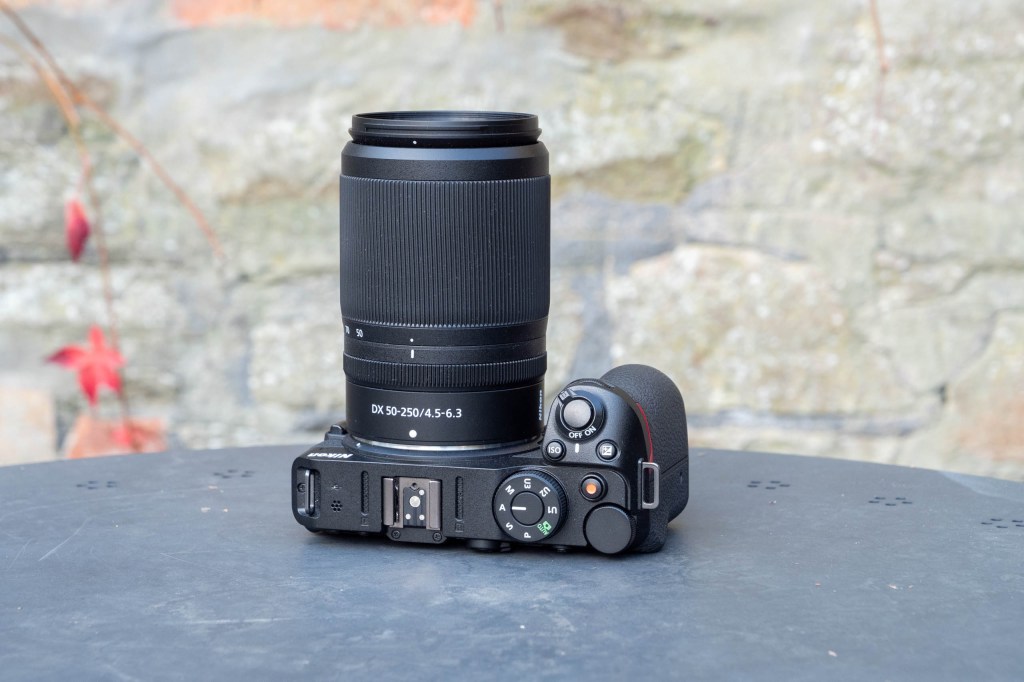Often bundled in as part of a kit package with a Nikon DX body and 16-50mm lens, the Nikkor DX 50-250mm f/4.5-6.3 gives you scope to shoot lots of different subjects with your APS-C Nikon model, including potentially sports, wildlife, portraits, macro, landscapes and much more besides.
As it’s to be used with a DX model, then the equivalent focal length is 75-375mm, and it’s also the longest focal length available from Nikon’s line-up of DX proprietary lenses. Longer lenses are available which are primarily designed for full-frame models, but most of those would undoubtedly be too big or heavy for most of Nikon’s APS-C models – they’re generally all pretty expensive too.
Nikon Nikkor Z DX 50-250mm f/4.5-6.3 VR – At a glance
- Price: $376 / £379
- Nikon Z mount (DX Format)
- Aperture: f/4.6-f/6.3 – f/22-f/32
- Min focus: 0.5m – 1m
Models in Nikon’s DX range include the Nikon Z50, the Nikon Zfc and the Nikon Z30 – we’ve used both the Z50 and the Z30 for this review. It is possible to use the lens with full-frame models, though it’s questionable whether you’d really want to. You might consider it as an option for cheaper full-frame Nikon models such as the Nikon Z5. If you attach it to an FX model, its crop mode will automatically kick in and you’ll find yourself shooting at a lower resolution. For something like the Nikon Z5 that means you’ll drop from shooting at 24MP down to 10MP – that might be perfectly fine for some smaller prints and so on, but it’s worth considering.
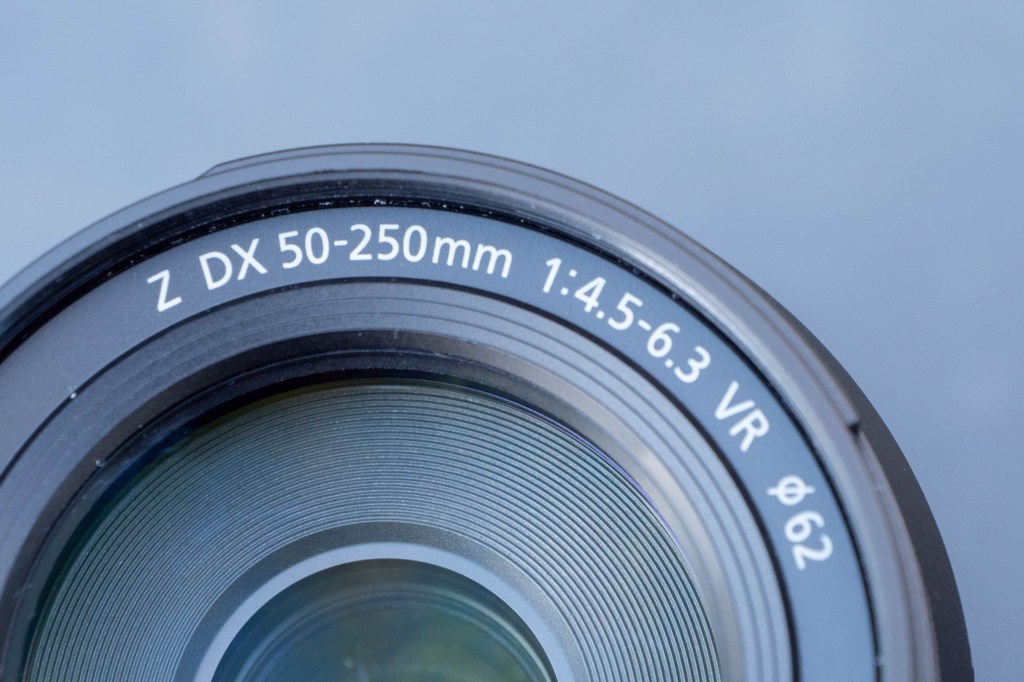
Even though it features a narrow maximum aperture, it should still let you create pleasing shallow depth-of-field shots. Photo: Amy Davies
Being available in a small, neat and inexpensive package comes with compromises of course. Here it’s that the maximum aperture is relatively narrow, starting at f/4.5 at the 50mm end, and going up to f/6.3 at the 250mm. Still, at longer focal lengths at least, you should be able to create some nice shallow depth of field effects, though it probably won’t be your first choice for shooting in low light.
An alternative to this lens, if you want a better “all-in-one” with a wider angle is the Nikon Nikkor Z 18-140mm f/3.5-6.3 VR, which has an equivalent focal length of 27-210mm – though of course you do lose the longer reach of the 50-250mm. At the time of writing, there’s no third-party superzoom lenses currently available directly for Nikon Z DX mount, though hopefully there will be some arriving at some point from the likes of Tamron or Sigma.
Nikon Nikkor Z DX 50-250mm f/4.5-6.3 VR – Features
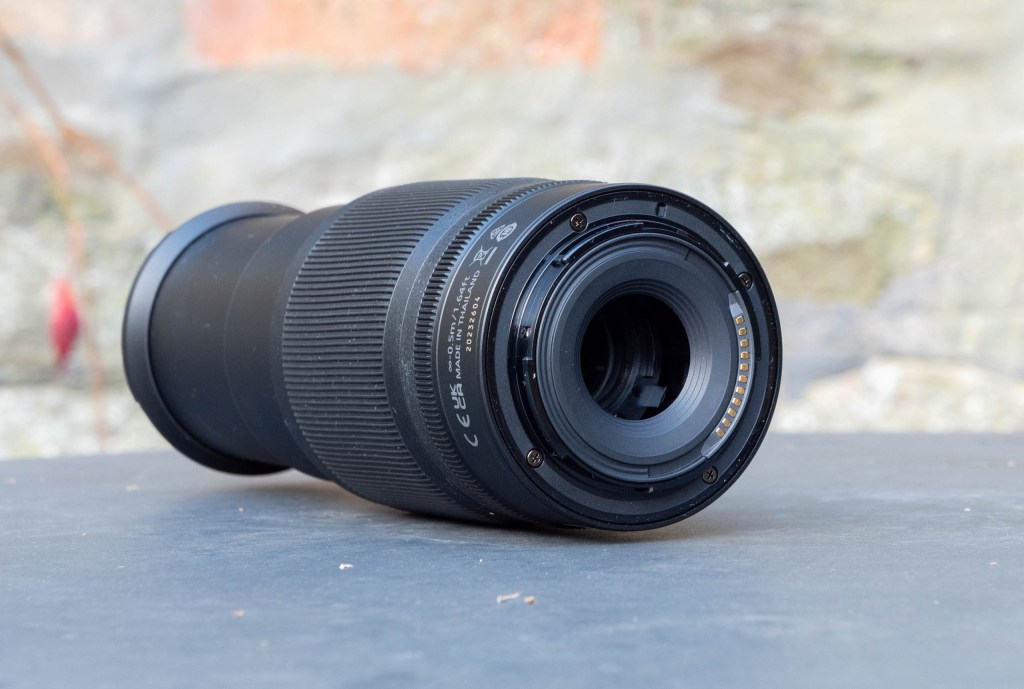
This low-cost lens doest have weather sealing, so you will need to take extra care when you are out and about. Photo: Amy Davies
The lens construction consists of 16 elements in 12 groups, including one ED element. The price and the size of the lens generally precludes any complex construction, and that’s what we see here. As such, we also don’t see any special coatings or weather-sealing, either – but that would be expecting quite a lot at a low cost.
There are seven diaphragm blades for creating out of focus areas, which are generally more pronounced at the longer focal lengths. This is not designed as a macro lens, but the focal length makes it suitable for shooting typical macro type subjects such as flowers and so on. The maximum reproduction ratio is 0.23x, and you can focus as close as 0.5m (at the 50mm end), rising to 1m at the 250mm end. Remembering that this measurement is taken from the sensor, rather than the end of the lens, you should find that it actually gets you quite close to some typical macro subjects in order to create frame-filling shots.
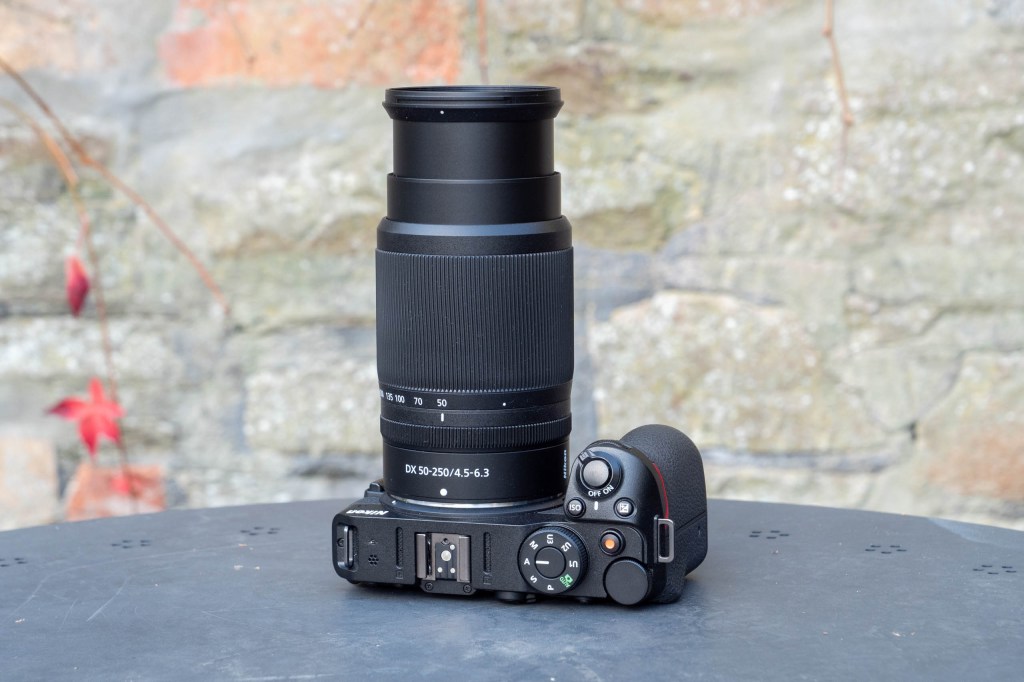
Nikon’s VR lenses feature a built-in vibration reduction that is useful for hand-held shots. Photo: Amy Davies
The lens has an internal focusing system, and pleasingly for a lens at this focal length, it also has inbuilt vibration reduction. This is particularly important as none of Nikon’s DX-format cameras include in-body image stabilisation, so you’ll probably find you’re relying on this if you want to shoot handheld at longer lengths. Nikon claims that the VR in the lens gives you up to five-stops of compensation. This also potentially makes the lens useful for video work, say if you’re a content creator using the Z30 for example.
Nikon Nikkor Z DX 50-250mm f/4.5-6.3 VR – Build and Handling
Covering a broad focal length range, the 50-250mm is quite long in length compared to other DX format lenses – but of course that’s exactly what we’d expect. That said, it can be retracted when not in use to save a significant amount of space in your bag. When retracted, it locks into place so it won’t accidentally extend when you don’t want it to either – particularly useful if you’re carrying it around your shoulder or neck.

It is a very compact lens, when retracted. Photo: Amy Davies
When extended to the shooting position, it’s a little unbalanced with smaller models like the Nikon Z30, but is better with the Z50 or Zfc, which have a chunkier build overall. This is especially true when at the full 250mm extension. Either way, as it’s quite light, it’s not too difficult to steady the lens and is worth the slight imbalance for the extra reach you get from it.
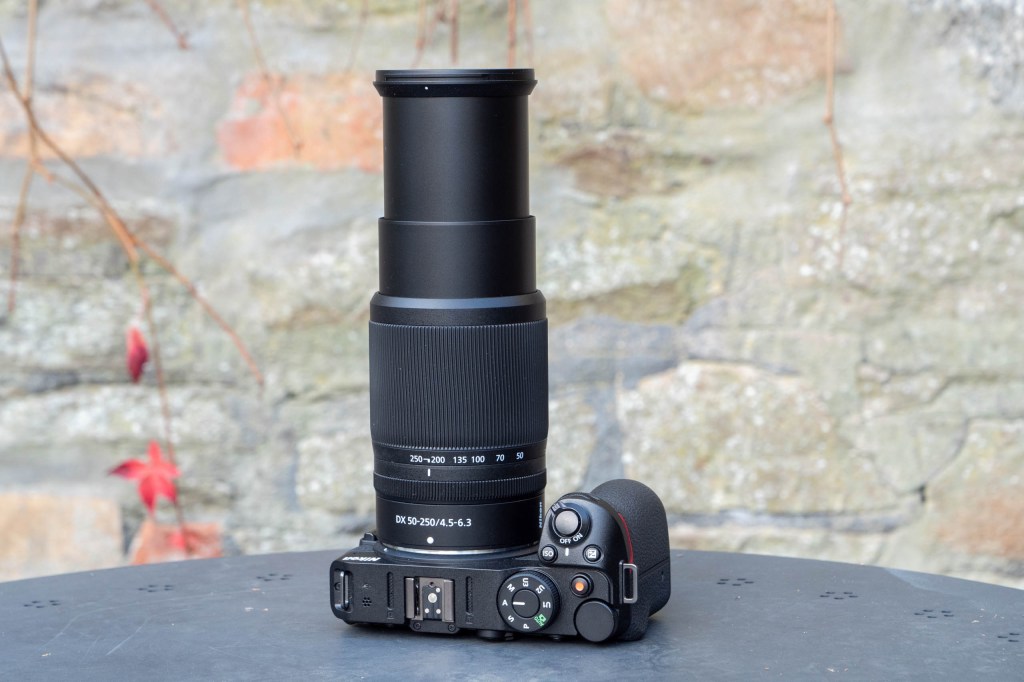
The lens balances well on a Nikon Z30 or Z50 body, even when fully extended. Photo: Amy Davies
The outward design of the lens is relatively simple. Most of the central part of the barrel is taken up with the zoom ring, which is marked in focal lengths of 50, 70, 100, 135, 200 and 250mm to help you quickly move between lengths just by sight alone. There’s a good amount of resistance to this ring, enabling smooth and precise changes between the focal lengths without it being too loose.
Another, much smaller, ring sits behind the zoom mechanism. With this, you can control various functions which are set via the camera’s main menu. Settings available here comprise of focus (M/A), aperture, exposure compensation and ISO sensitivity. You can also set the ring to control nothing at all if you’re worried about accidentally knocking it.
Otherwise, there’s no buttons or switches. If you want to switch off vibration reduction in the lens, you can do that via the main menu – bear in mind that it’s not generally necessary any more to switch it off when using tripods, so the lack of a dedicated switch isn’t particularly annoying.
The lens can be used with 62mm filters, and it is compatible with the HB-90A Bayonet Hood – though note, one doesn’t come included in the box so if you want one you’ll have to purchase it separately.
Nikon Nikkor Z DX 50-250mm f/4.5-6.3 VR – Autofocus
For the most part, autofocusing is fairly quick – certainly as quick as we’d expect from a lens of this price and quality and with the types of cameras you’ll be using it with. It might not be able to keep up with the fastest of action subjects, but on the whole it’ll do a decent job.

The 50-250mm lens focuses quickly and quietly for the most part Photo: Amy Davies
It’s also fairly quiet at focusing. You can just about hear some focusing noise if you hold the lens close to your ear, but otherwise it works very well in quiet situations, while video work isn’t adversely affected by focusing noise either.
In very low light, the lens has a little more trouble locking onto the subject than in good light – again to be expected for its class.
Nikon Nikkor Z DX 50-250mm f/4.5-6.3 VR – Image Quality
It’s fair to say that a superzoom lens like this is unlikely to boast superior image quality, especially for the price. However, it does a good job of creating images with a decent overall impression of sharpness – especially when looking at normal printing and viewing sizes.

The 50-250mm lens at the wide-angle end of the lens (50mm – 75mm equivalent) Photo: Amy Davies

The 50-250mm lens at the telephoto end of the lens (250mm – 375mm equivalent) Photo: Amy Davies
That level of sharpness is maintained throughout the focal range, with images taken at the far reach only very marginally softer than that at the wide-angle end – and only really if you’re examining closely. The relatively close focusing distance and focal length make it a good choice for macro-type subjects, where the amount of detail is certainly good enough for those experimenting with the genre.

The amount of detail on display is pretty good for a lens of this class. Photo: Amy Davies

Reasonably shallow depth of field effects are visible even at the 50mm end. Photo: Amy Davies
Although the aperture range is narrow, it’s still possible to create some shallow depth-of-field effects. This can be achieved even at the 50mm f/4.5 end, but is more pronounced as you move through the focal length range. As such, it’s a reasonable option for portraits and the like – especially if you don’t want to spend big on expensive prime lenses.
Distortion doesn’t seem to be a problem here – although it’s not something we’d really expect to see on a telephoto lens like this anyway. Vignetting also doesn’t seem to show up, even at the widest apertures – again, with them not being very wide in the first place, that’s probably to be expected.

Still life shots are a good choice for this lens. Photo: Amy Davies
For the most part, chromatic aberration, in the form of blue or purple fringing, isn’t particularly obvious. You might see some against hard contrast edges in bright conditions if you zoom in at 100%, but it’s not something that seems to bother most images.
Overall, although is not a lens you’re going to select for superior sharpness, for a travel zoom which covers off a lot of subjects, it’s a handy addition to your kit bag.
Nikon Nikkor Z DX 50-250mm f/4.5-6.3 VR – Verdict
If you’ve got a Nikon DX format camera – or you’re thinking of buying one – then the 55-250mm lens is likely to be something you’re thinking about getting too.

The 50-250mm opens up a lot of subjects to Nikon DX format users, such as wildlife. Photo: Amy Davies
It’s ideal to pair with the 16-50mm standard kit lens and extends your scope for shooting a fairly limited range of subjects by quite some way. With this, beginners especially, have good access to things like portraits, wildlife, sports, architecture, macro, events and more besides.
As a travel photography kit, it also makes a lot of sense too, being small and light enough to pack into a small bag, while giving you access to those faraway subjects you might not otherwise be able to reach.
Arguably, the 18-140mm is a more versatile travel optic, but if you want the longer reach, then this is the one to go for. You might also want to consider the 50-250mm lens as a “just in case” option, especially if you don’t shoot the kind of subjects that require a long focal length all that often.
At under $400/£400 (and in some places even cheaper), this is a good value lens to add to your kit bag if you’re looking to buy it separately. And we’d definitely argue that if you’re looking at buying the Z30 or Z50 anyway, it’s worth looking for a bundle deal that includes it – usually a double lens bundle only increases the price by about £100/$100 or so, making the lens even more of a bargain.
In an ideal world, third-party manufacturers would make some superzoom lenses for the Nikon DX format, but for now, the 50-250mm is a great value lens that is recommended for beginners and enthusiasts looking to round out their kit bag.

Related reading:
- Nikon Z50 review
- Best Nikon mirrorless cameras to buy in 2023
- Nikon Z5 review – full-frame mirrorless, for less
Follow AP on Facebook, Twitter, Instagram, YouTube and TikTok.

